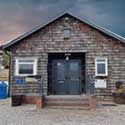
Village schools 1930s-40s UK

This page gives personal recollections of being a pupil at a small rural village school in the 1930s and 40s. A feature is the description of how the school was used for schooling evacuees in addition to the village children during the Second World War.
____
By Anne Davey (1933-2017) who attended a village school before and during World War Two, edited by the webmaster
My school where I was living with my grandparents in the late 1930s and early 1940s catered for 4½ to 14 year olds with just two teachers. It probably hadn't changed much since Victorian times. It was a typical rural, village school.
The school building and site
There was just one large class room divided by a partition which folded back. The little children were in one half and the older ones in the other.
There was a dark cloakroom (little more than a corridor really) where we were banished for any misdemeanours. I was often out there for not knowing my tables.
The lavatories were in an outbuilding.
There was a tarmac playground but no playing field. For sports we used a farmer's meadow.
The teaching
WW2 evacuees and school teaching
Note from the webmaster
From talking to various people, it seems that most places which received evacuees had two separate lots of half day teaching - one for the village children, with village teachers, and the other for the evacuees with their own teachers who were evacuated with them.
We sat in rows of two-person desks facing the teacher and the blackboard. Her desk was near the stove! Youngest children were at the front, oldest at the back. A great deal was learnt by rote. We had slates until we could write properly and progressed to books with pencil and then pen and ink.
The vicar played an active part in our school life; he took us for religious education and heard us singing.
How we learnt writing
I attended a local old-fashioned school house where about 15 children of all ages were taught by one teacher and in one room. Writing was on framed slate and using the slate equivalent of a pencil; a damp cloth removed anything written; most economical.
Albert Smith
There was no afternoon school once the evacuees arrived, because the village children went to school in the mornings with the village teachers and the evacuees went to school in the afternoon with their own teachers. Until then, probably very little about the school had changed since Victorian times.
Heating in the school
There was a large round tortoise-cast iron stove in each half with a big iron guard round. It was particularly handy for drying clothes and shoes in bad weather, as a lot of the children walked long distances and their families were too poor to buy waterproof clothing. My best friend, for example, was one of ten children and her father was a shepherd.
School milk and food supplements
School milk came in 1/3 pint bottles and we had it free every morning at playtime.
I think that why my generation are generally healthy is that our childhood food was fresh and unprocessed. We were rationed so we didn't overeat, and as hygiene was basic, we certainly ate our 'peck of dirt'. On the hygiene front, we were all given cod liver oil and malt each morning at school. We were lined up for our spoonful - ONE spoon for all - no cleaning in between each child! Oh great days!
Seasonal out-of-school activities in the open air
Once we village children were free in the afternoons, we had to amuse ourselves. We were out off doors in most weathers.
We had the usual games in their season - skipping, ball games, hoops, marbles, conkers.
Opposite the school was an embankment with huge old chestnut trees. Lots of roots were exposed down the bank where we played 'houses' and 'shops'. The dips and holes were cooking places or cupboards. Our 'food' was conkers, acorns, seeds and 'hips & haws' (hawthorn).
We ate the young leaves of the hawthorn, made pipes with elder twigs, crushed elderberries for drinks or just ate them as they came off the tree.
We picked wild flowers in the Spring - primroses and violets.
In the Autumn we collected rose hips for the Government to make Rose Hip Syrup (for vital Vitamin C). We were paid 2d for each pound we collected.
The Autumn harvest was another great time - watching the binders and the corn being stooked, with the men chasing the rabbits and the women gleaning for chicken feed.
Text and images are copyright
If you can add anything to this page or provide a photo, I would be pleased if you would contact me.
sources: early 20th century material
sources: ww2 home front and other material
contact
the webmaster/author/researcher/editor
privacy policy
















